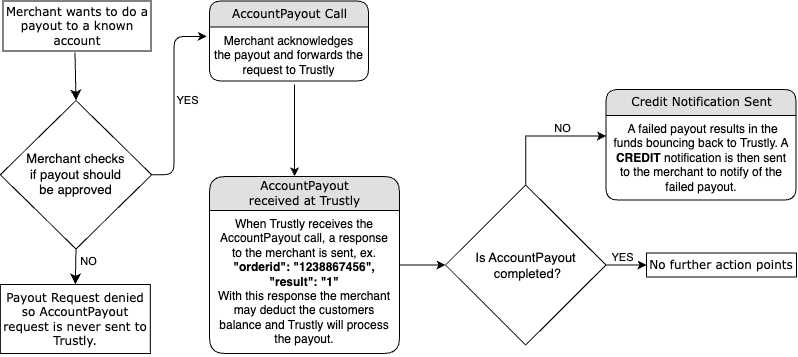Transfer money
Build integration for customers to transfer money from one bank account to another
Before you start
- Make sure that you have completed Sign up and received a Trustly test account.
- If you have a native app implementation, integrate Trustly SDKs.
Money transfer flows
Providing remittence services for money transfer consists of deposit and payout flows.
Deposit flow

A typical Deposit flow
In a typical Deposit flow:
- Your customer enters the amount for transfer in your checkout.
- Your system sends an API call to Deposit .
- Trustly responds with a checkout URL and order ID.
- Your system redirects the customer to the Trustly checkout where they log in to their bank and authorise the payment.
- The customer will be redirected from the Trustly checkout to SuccessURL specified in the deposit API call.
- Depending on the outcome, Trustly may send any of the following notifications:
- Cancel notification if the checkout process is interrupted.
- Pending notification when the customer has completed the checkout process.
- Account notification Trustly sends information about the bank account used in this order.
- Credit notification when the payment has arrived at your Trustly account.
- Debit notification if the transaction fails after the credit notification is sent.
Note: Account, Pending, Credit notifications can arrive in any order. The Account notification is not enabled by default. Contact Trustly Integration Support, if you need it.
- Your system responds to the received notifications.
Payout flow

A typical payout flow
A typical payout flow is:
-
Your system sends an API call to AccountPayout with the
AccountIDfrom the previous Deposit. -
Trustly responds with a
resultandOrderIDin a synchronous response to let you know that theAccountPayoutrequest has been received and the payout is being processed.. -
Trustly may send the following notifications:
- Debit notification when the customer's balance has decreased.
- Credit notification when the withdrawal has failed or been denied by you.
- Account notification gives you information about the bank account that is selected by the customer.
- Payout confirmation sent to your system in order to confirm that a payout has been sent.
- Cancel notification when the withdrawal has been cancelled or failed.
- Your system responds to the received notifications.
Step 1: Integrate your system with Trustly
The business logic for transferring money consists of deposit and payout flows to transfer money from one bank account to another.
- Make sure that your integration follows Security requirements.
- A customer makes a request to transfer money.
- Your system sends an API call to
Deposit. - Trustly responds with a Trustly URL, your system presents the URL to let the customer deposit money.
- Once the deposit is successful, Trustly sends a credit notification.
- Your system sends a call to
AccountPayout. - Trustly returns a synchronous response to let you know that the
AccountPayoutrequest has been received and the payout is being processed.Make sure that your system logs and handles error codes that are returned from API calls. See Error handling. - Make sure that your integration responds correctly to notifications that Trustly may send out.
Step 2: Design service presentation
When your integration presents a Trustly URL to customers, the presentation must follow Trustly checkout guidelines.
Step 3: Do acceptance testing
Prior to going live, the Trustly Integration Specialist will perform Acceptance testing. Make sure your integration has passed all test cases, including:
- Deposit API calls
- AccountPayout API calls
- Built-in test cases of acceptance testing: D1 to D5, and G1 to G3
- Verify that your integration has correct responses to notifications. See Notification tool.
Step 4: Verify and go live
Follow the instructions to go live.
Updated 8 months ago
